
Larix griffithii, the Sikkim larch, is a species of larch, native to the eastern Himalaya in eastern Nepal, Sikkim, western Bhutan and southwestern China, growing at 1,800–4,100 metres (5,900–13,500 ft) in altitude.
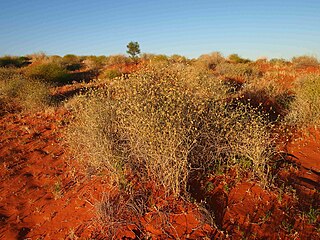
Zygochloa is a genus of desert plants in the grass family known only from Australia. The only known species is Zygochloa paradoxa, commonly known as sandhill canegrass. It occurs in extremely arid areas such as the Simpson Desert.
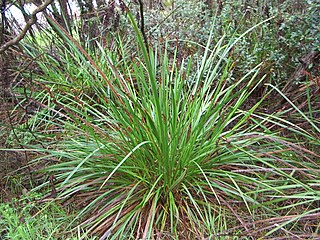
Lepidosperma is a genus of flowering plant of the family Cyperaceae. Most of the species are endemic to Australia, with others native to southern China, southeast Asia, New Guinea, New Caledonia and New Zealand.
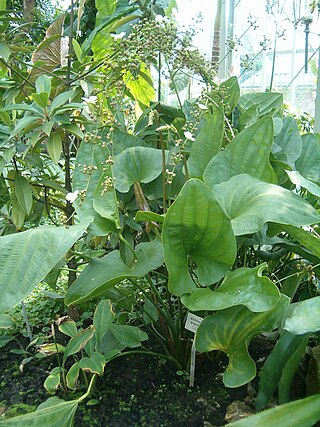
Echinodorus grandiflorus is a plant species in the Alismataceae. It is native to Brazil, Paraguay, Uruguay, Argentina, Venezuela and Florida.

Lepidosperma longitudinale is commonly known as the pithy sword-sedge or pith saw-sedge. It is an evergreen species of sedge that is native to swampy areas of most Australian states. It was described by French botanist Jacques Labillardière in 1805.

Carex binervis, the green-ribbed sedge, is a European species of sedge with an Atlantic distribution. It is found from Fennoscandia to the Iberian Peninsula, and occurs in heaths, moorland and other damp, acidic environments. It typically grows to a height of 15–120 cm (6–50 in), and has inflorescences comprising one male and several female spikes, each up to 45 mm (1.8 in) long. The utricles have two conspicuous green veins, which give rise to both the scientific name and the common name of the species. In the vegetative state, it closely resembles C. bigelowii, a species that usually grows at higher altitude. C. binervis was first described by James Edward Smith in 1800, and is classified in Carex sect. Spirostachyae; several hybrids with other Carex species are known.

Lepidosperma laterale, commonly known as the variable swordsedge, is a plant found in south-eastern Australia, New Caledonia and New Zealand. It is often found on sandy soils or rocky areas in wooded areas.

Pachyphytum is a small genus of succulents in the family Crassulaceae, native to Mexico, at elevations from 600 to 1,500 metres. The name comes from the ancient Greek pachys (=thick) and phyton (=plant) because of the shape of the leaves.

Lepidosperma filiforme, also known as the common rapier-sedge, is a sedge that occurs in coastal regions of south-eastern Australia and New Zealand. Plants grow to between 0.3 and 1 metre high. The culms are smooth, rigid, terete and between 0.7 and 2 mm in diameter. The leaves are also terete and about 1 mm in diameter, with sheaths that are straw coloured or reddish.

Acalypha gracilens is a species of flowering plant in the family Euphorbiaceae. Common names include slender threeseed mercury; three-seeded mercury; shortstalk copperleaf; slender copperleaf. It is native to the south-eastern United States.
Catananche lutea, is a woolly annual plant, in the family Asteraceae, with most leaves in a basal rosette, and some smaller leaves on the stems at the base of the branches. Seated horizontal flowerheads develop early on under the rosette leaves. Later, not or sparingly branching erect stems grow to 8–40 cm high, carrying solitary flowerheads at their tips with a papery involucre whitish to beige, reaching beyond the yellow ligulate florets. Flowers are present between April and June. This plant is unique for the five different types of seed it develops, few larger seeds from the basal flowerheads, which remain in the soil, and smaller seeds from the flowerheads above ground that may be spread by the wind or remain in the flowerhead when it breaks from the dead plant. This phenomenon is known as amphicarpy. The seeds germinate immediately, but in one type, germination is postponed. It naturally occurs around the Mediterranean. Sources in English sometimes refer to this species as yellow succory.

Machaerina juncea, commonly known as bare twig-rush or tussock swamp twig rush, is a sedge in the sedge family, Cyperaceae, that is native to Australia, New Zealand, and New Caledonia.
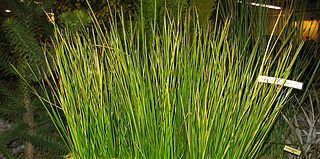
Machaerina rubiginosa, commonly known as soft twig rush, flat leaf twig rush or common twig rush, is a flowering plant in the sedge family, Cyperaceae, that is native to Asia and the Pacific.
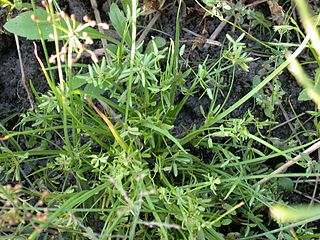
Cyperus flaccidus is a sedge of the family Cyperaceae that is native to Australia.

Cyperus gilesii, commonly known as Giles' flat-sedge, is a sedge of the Cyperaceae that is native to Australia.

Lepidosperma canescens is a sedge of the family Cyperaceae that is native to south-east South Australia and Victoria. There are no synonyms.

Wachendorfia thyrsiflora, the marsh butterfly lily, is a plant species of 0.6–2.5 m (2.0–8.2 ft) high when flowering, that has been assigned to the bloodroot family. It is a large to very large evergreen perennial plant with an underground rootstock with clusters of roots produced at the nodes. The rootstock has a distinctive red colour that results from so-called arylphenalenone pigments. The sturdy, entire and broadly sword-shaped leaves have laterally flattened and pleated leaf blades. The golden yellow flowers are set a dense cylindrical panicle on a tall firm stalk. Flowering occurs from spring until mid-summer.
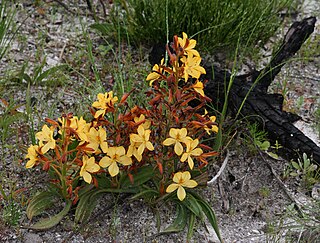
Wachendorfia paniculata is a species of plant of 10–90 cm (3.9–35.4 in) high, that emerges during the winter from an underground rootstock. It has entire, sword-shaped, mostly hairy, line- to lance-shaped, straight or sickle-shaped leaves, set in a fan at ground level with a lax to dense panicle consisting of pale apricot to yellow mirror-symmetric flowers with six tepals, three stamens and a undivided style that curves either to the right or left. The species is assigned to the bloodroot family. Flowering occurs between August and December at sea level, and until early February at high altitude, with a distinct peak from September to November. It can only be found in the Cape provinces of South Africa. Like other species of Wachendorfia, it is called butterfly lily in English and rooikanol or spinnekopblom in Afrikaans, and this species in particular is also called koffiepit in Afrikaans.

Wachendorfia brachyandra is a small to large, 10–65 cm (3.9–25.6 in) high, winter-growing, perennial herbaceous plant that grows from a rootstock, and has been assigned to the bloodroot family. Its simple, entire, line- to lance-shaped leaves that are usually shorter than the stem, and have pleated, laterally flattened leaf blades af about 35 mm (1.4 in) wide, meaning that there are left and right surfaces rather than upper and lower. The inflorescence is a lax panicle and at the base of each flowerstalk is a dry, brown and papery bract, and those higher in the panicle have a recurved tip. The mirror-symmetrical pale apricot-yellow flowers consist of six tepals and are adorned with brown markings on the upper three tepals. There are three anthers that are clustered and about half as long as the tepals. Each individual flower only lasts one day. Flowering occurs from August to December. This species grows in the wild in the Western Cape province of South Africa only, and is much less common than its relatives W. paniculata and W. thyrsiflora. It is sometimes called short-stamen butterfly-lily in English.
Carex cephalotes, also known as wire-head sedge, is a tussock-forming species of perennial sedge in the family Cyperaceae. It is native to south eastern Australia and New Zealand.




















